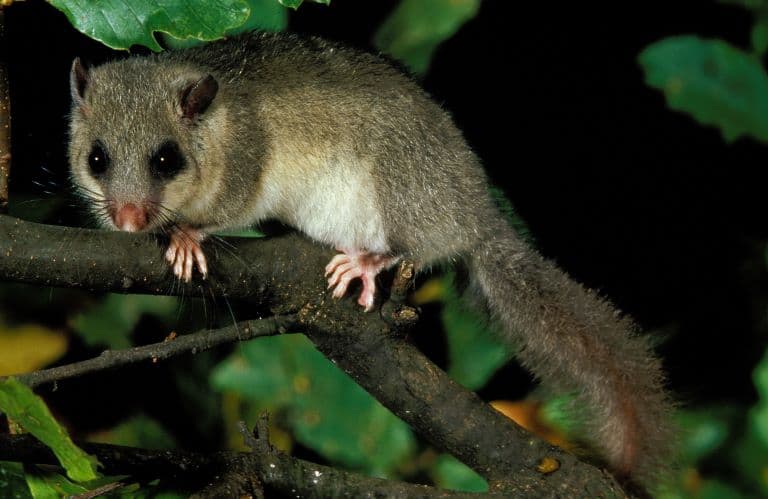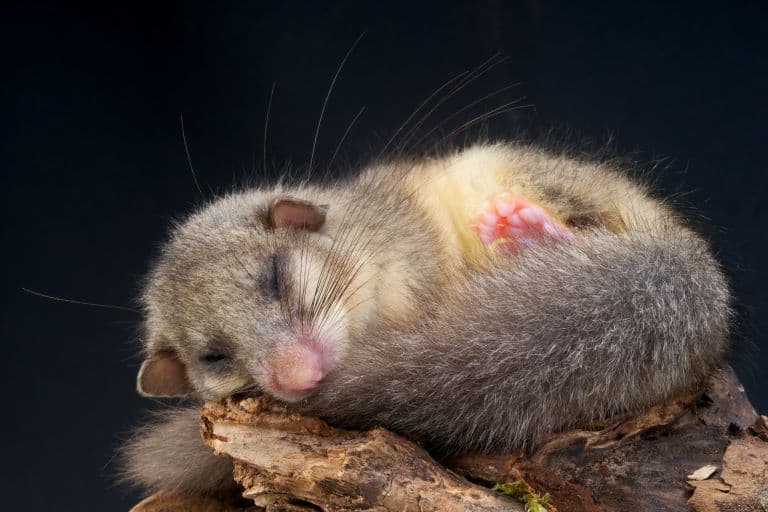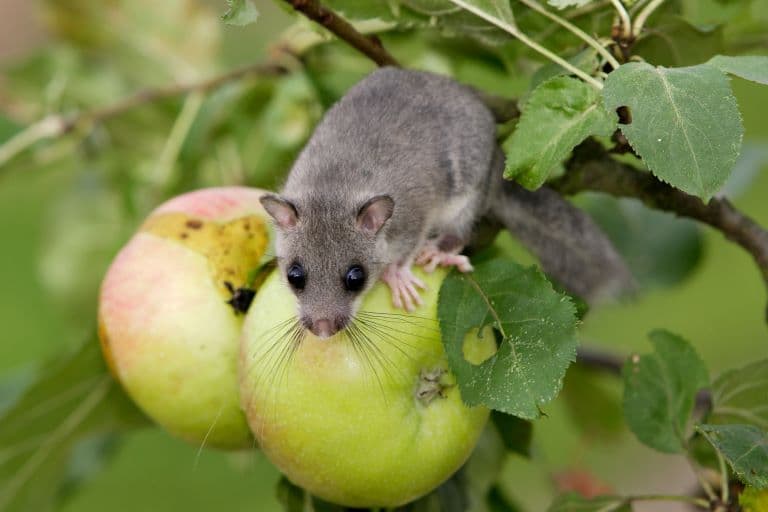Edible Dormouse Profile
Sometimes, animals are named after food. Honey badgers, pineapple fish, tomato frogs and coconut crabs are all going to be disappointing in a culinary setting. But others, like the edible dormouse, might just be so tasty they are restricted by law.

Edible Dormouse Facts Overview
| Habitat: | Deciduous forests, vegetation, orchards, hedges, urban margins |
| Location: | Europe, Iran and parts of western Asia |
| Lifespan: | Up to 12 years |
| Size: | 19 cm (7.5 in) plus a 13-cm-long tail |
| Weight: | 150 g (5.3 oz), may double before hibernation |
| Colour: | Grey to greyish-brown with white to pale buff underparts |
| Diet: | Seeds, nuts, shoots, fruit |
| Predators: | Owls, snakes, foxes, pine martens, weasels, wildcats |
| Top Speed: | Not recorded |
| No. of Species: | 2 |
| Conservation Status: | Least concern (G. glis), not evaluated (G. persicus) (IUCN) |
One of Britain’s cutest invasive species is an arboreal mouse that’s widespread on the mainland. Sadly, it’s displacing the native cousin on the British Isles, and is one of two known species that make up the most delicious rodent in antiquity.
A flavourful pest seems to present its own solution, and perhaps the people of Britain have to be nudged back towards some medieval recipes to help solve the problem.
Outside of the islands though, they’re very comfortable, hibernating for much of the year and gnawing through cables for a few years before dying peacefully in their beds.
Interesting Edible Dormouse Facts
1. There are now two
In 2013 several species in the genus Glis were reclassified into the genus Myoglis, leaving the European edible dormouse entirely alone in its genus.
But not for long! In 2021, the Iranian strain of dormouse became recognised as a separate species from the well-known European dormouse, which is now the largest dormouse in the world.
And the size of this animal, also known as the ‘fat dormouse’, is causing a bit of a problem for British rodents.
2. They have a complicated history in Britain
The edible dormouse isn’t native to the UK and was introduced by accident in 1902. Despite being a delicacy for the Romans, they never thought to bring it to Britannia, and it was instead released into the wild from a Rothschild collection in Tring.
And this is a bad thing because despite how cute it might appear, this rodent has become a bit of a pest.
Britain already has its own dormouse, the even cuter hazel dormouse, and this invader from the mainland is now threatening to displace it.
The charisma of the edible dormouse might have something to do with how it infiltrated the ecosystem undeterred, but there are also some blind spots in the regulations that need to be fixed.
The Countryside Act prevents their senseless killing because the family Gliridae is protected by the law, so now Britain has an invasive species that is so far untouchable. 1 2

3. They’re troublemakers
The strength of their interference comes from a strong adaptation to living alongside humans. These mice are notorious hibernators and will occupy attics and sheds, where they’ll drag various quantities of kingling into close proximity with electrical cables to form nests.
They’re also rodents, so they gnaw on everything and poo everywhere, which shouldn’t endear anybody to them either. House fires have been caused by this species, notably one in Tring, where they were first released, caused by a dormouse chewing through a broadband cable.
They can also strip the bark from trees, destroy fruit crops, and push out the native rivals with their superior size and appetites.
But there’s one solution to this that nobody appears to be discussing. 3

4. They’re edible
The Romans brought a lot of things to Britain; potatoes, gladiator battles and that Latin message around the Queen’s head on the £1 coins to name a few of the incredible contributions the imperial colonisers bestowed upon the humble savages they found there.
But interestingly, they didn’t bring their best stuff. The Roman cookbook Apicius has the following description of what the Isles missed out on until the rodent was released in 1902:
“Stuff the dormice with minced pork as well as the flesh from all of the dormouse’s limbs, together with ground pepper, pine nuts, laser [an extinct type of fennel] and liquamen [fermented fish sauce] and place them sewn up on a clay tile in the oven or cook them in a roasting pan.”
This meal was considered particularly extravagant and would be presented at very swanky events. The emperor Claudius considered this recipe so exquisite that he banned it from Martial’s list of 223 possible Saturnalia guest gifts because it was just too good.
Dormice in Rome would be farmed in jars and fattened up with chestnuts, walnuts and acorns before preparing them into meals. They were immensely popular; as a host, the fatter your dormice, the higher your social standing.
In Elizabethan times, the fat from this sleepy mouse was considered as a treatment to induce slumber and even today, you can still find dormouse served in parts of Croatia and Slovenia. 4
5. Their tails fall off
If you spent your childhood catching lizards, you may have discovered the hard way that some of them can detach their tails.
This is known as caudal (tail) autonomy and is something seen mostly in reptiles and amphibians. But the edible dormouse has a rudimentary version of this skill too.
At least 35 species of rodents are known to do this, some are better at it than others. In the edible dormouse, the shedding of the tail isn’t complete and is known as “false tail autonomy”, but this doesn’t make it any less weird.
When trapped by a cat’s paw or a hungry Roman finger, the dormouse can shed the skin on the tail, essentially degloving (don’t look up that word) it, and freeing the animal. The vertebrae remain attached and will dry out and fall off, or in some cases grow fresh skin and fur back. 5
6. Their sex is expensive
Not all males are sexually active at once in this species, as, in classic dormouse fashion, even their sex is about conserving energy.
There are high energetic costs associated with dormouse reproduction, which creates significant pressure on the animals to be at their best when mating.
This might be one of the reasons they spend so much of their time asleep. 6
7. They hibernate in several ways
Edible dormice have the sleeping habits of a university student.
There are three major ways a mammal enters a dormant state: hibernation, estivation, and daily torpor. We’re familiar with the first, often seasonal, naps; estivation is related to higher temperatures, rather than winter ones, and daily torpor is a reduced metabolic state that serves to expend as little energy as possible; similar to the condition that’s made Netflix so profitable.
Edible dormice make use of all three of these types of rest and as such spend around half of the year asleep. They’re more active in the summer, but even then they try not to spend more than about three hours awake.
During their deepest sleeps, they can go an hour without taking a breath, and when there’s really nothing to eat they might sleep for 11 months.

8. They die well
All this sleeping means it’s statistically likely they’ll die in their beds, and for this little mouse, they mostly do.
If they can survive being eaten, the most common cause of death is a lack of food, and this means that they’ll last a good four years or so and then fail to sufficiently fatten up for their hibernation. This is often caused by their teeth wearing down to the point they can’t eat enough during their waking hours.
In its final year, this cute little pest will curl itself up in a nest made of your shredded mattress fibres and cardigans, take one last bite on your TV aerial and fall asleep for the very last time. Not a bad way to go, really.
Edible Dormouse Fact-File Summary
Scientific Classification
| Kingdom: | Animalia |
| Phylum: | Chordata |
| Class: | Mammalia |
| Order: | Rodentia |
| Family: | Gliridae |
| Genus: | Glis |
| Species: | G. glis, G. persicus |
Fact Sources & References
- “Hazel dormice: protection and licences”, Gov.uk.
- PA News Agency “Hazel dormice should be classified as endangered, new research suggests”, Bracknell News.
- Richard Gray, “Edible dormouse listed among Britain’s great wildlife threats”, The Telegraph.
- CARLY SILVER (2017), “The Dormouse-Fattening Jars of Ancient Rome”, Atlas Obscura.
- Rimvydas Juškaitis (2006), “Tail autotomy in the common dormouse ( Muscardinus avellanarius): Some ecological aspects”, Research Gate.
- Joanna Fietz (2003), “Energetic constraints on sexual activity in the male edible dormouse (Glis glis)”, Research Gate.
